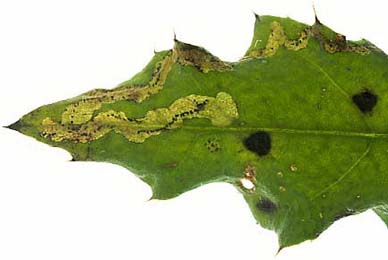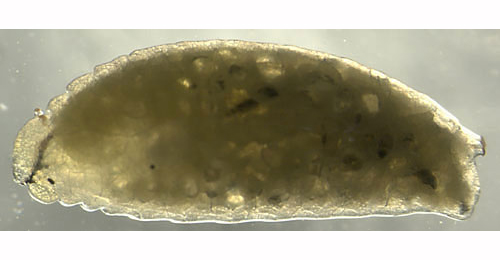Phytomyza
cirsii Hendel, 1923
[Diptera:
Agromyzidae]
Phytomyza
cirsii
Hendel, 1923a. Dt. ent. Z. 1923(4):390
Phytomyza cirsicola Hendel, 1927a. Zool. Anz. 69:
258
Phytomyza cirsii Hendel, 1923a; Spencer, 1972b. Handbk
ident. Br. Ins. 10(5g): 71, 72 (fig. 233A), 77, 79,
112
Phytomyza cirsii Hendel, 1923a; Spencer, 1976. Fauna
ent. Scand. 5(1): 404-5, figs 647B, 707.
Phytomyza cirsii Hendel, 1923a; Spencer, 1990. Host
specialization in the World Agromyzidae (Diptera) : 251, 255,
256 (fig. 957), 259.
|
Leaf-miner: A
shallow, upper surface, whitish linear mine. Pupation external (Spencer, 1972b: 72 (fig. 233A), 77).
Tortuous,
upper-surface corridor, often somewhat geryish, and/or following
the leaf margin. Frass grains fairly small, separated by about their
own diameter. Primary feeding lines often conspicuous. Pupation
outside the mine; exit slit in upper epidermis (Bladmineerders van Europa).
A long whitish upper surface mine. The frass grains are small and can occur close together (British
leafminers).
Larva: The larvae of flies are leg-less maggots without a head capsule (see examples). They never have thoracic or abdominal legs. They do not have chewing mouthparts, although they do have a characteristic cephalo-pharyngeal skeleton (see examples), usually visible internally through the body wall.
The larva is illustrated in Bladmineerders van Europa.
Puparium: The puparia of flies are formed within the hardened last larval skin or puparium and as a result sheaths enclosing head appendages, wings and legs are not visible externally (see examples).
Black; posterior spiracles each with an ellipse of up to 26 minute
bulbs (Spencer, 1972b: 77).
Hosts in Great Britain and Ireland:
Hosts
elsewhere:
| Apiaceae |
|
|
|
|
| Aegopodium |
|
|
|
Bladmineerders van Europa |
| Anthriscus |
|
|
|
Spencer,
1990: 159 |
| Anthriscus |
caucalis |
Bur
Chervil |
 |
Bladmineerders van Europa, as Anthriscus neglecta
|
| Anthriscus |
cerefolium |
Garden Chervil |
|
Bladmineerders van Europa |
| Anthriscus |
nemorosa |
|
|
Bladmineerders van Europa |
| Anthriscus |
sylvestris
|
Cow
Parsley |
 |
Spencer,
1976: 401 |
| Anthriscus |
sylvestris
|
Cow
Parsley |
 |
Bladmineerders van Europa |
| Bifora |
|
|
|
Bladmineerders van Europa |
| Bifora |
|
|
|
Spencer,
1990: 159 |
| Bifora |
|
|
|
Bladmineerders van Europa |
| ?
Carum |
|
|
|
Spencer,
1976: 401 |
| Carum |
|
|
|
Spencer,
1990: 159 |
| Carum |
carvi |
Caraway |
 |
Bladmineerders van Europa |
| Chaerophyllum |
|
|
|
Spencer,
1976: 401 |
| Chaerophyllum |
|
|
|
Spencer,
1990: 159 |
| Chaerophyllum |
aromaticum |
Broad-leaved
Chervil |
|
Bladmineerders van Europa |
| Chaerophyllum |
aureum |
Golden
Chervil |
|
Bladmineerders van Europa |
| Chaerophyllum |
bulbosum |
|
|
Bladmineerders van Europa |
| Chaerophyllum |
hirsutum |
Hairy
Chervil |
|
Bladmineerders van Europa |
| Chaerophyllum |
temulum
|
Rough
Chervil |
 |
Bladmineerders van Europa |
| Conium |
|
|
|
Spencer,
1990: 159 |
| Conium |
maculatum
|
Hemlock |
 |
Spencer,
1976: 401 |
| Conium |
maculatum
|
Hemlock |
|
Bladmineerders van Europa |
| Conopodium |
|
|
|
Spencer,
1990: 159 |
| Conopodium |
majus
|
Pignut |
 |
Bladmineerders van Europa |
| Conopodium |
majus
|
Pignut |
 |
Spencer,
1976: 401 |
| ?
Daucus |
|
|
|
Spencer,
1976: 401 |
| Daucus |
|
|
|
Spencer,
1990: 160 |
| Daucus |
carota
|
Carrot |
 |
Bladmineerders van Europa |
| Myrrhis |
odorata
|
Sweet
Cicely |
 |
Bladmineerders van Europa |
| Oenanthe |
aquatica |
Fine-leaved
Water-dropwort |
 |
Bladmineerders van Europa |
| Orlaya |
|
|
|
Spencer,
1990: 159 |
| Orlaya |
grandiflora
|
Large-flowered
Orlaya |
|
Bladmineerders van Europa |
| Selinum |
|
|
|
Spencer,
1990: 160 |
| ?
Sison |
|
|
|
Spencer,
1976: 401 |
| Sison |
|
|
|
Spencer,
1990: 160 |
| Sison |
amomum |
Stone
Parsley |
 |
Bladmineerders van Europa |
| ?
Torilis |
|
|
|
Spencer,
1976: 401 |
| Torilis |
|
|
|
Spencer,
1990: 160 |
| Torilis |
japonica
|
Upright
Hedge-parsley |
 |
Bladmineerders van Europa |
Time
of year - mines: April-July, November. First generation mines
normally in April, but larvae can be found feeding throughout the
winter.
Time
of year - adults: Currently unknown.
Distribution
in Great Britain and Ireland: Common and widespread throughout
Britain (Spencer, 1972b:
92) including Warwickshire (Coventry) (Robbins,
1991: 64) and Inner Hebrides (Isle of Coll) (Bland,
1992); Cambridgeshire, Cumberland, Denbighshire, East Gloucestershire, East Suffolk, Easterness, Leicestershire, Main Argyll, Mid-west Yorkshire, Nottinghamshire, South Lancashire, South-east Yorkshire, South-west
Yorkshire and Surrey (NBN
Atlas).
Also
recorded in the Republic of Ireland (Fauna Europaea) and National Biodiversity Data Centre Map). Distribution
elsewhere: Widespread and common throughout much of Europe including
Denmark, Finland, Norway, Denmark (Spencer,
1976: 401), The Netherlands, Luxembourg (Bladmineerders van Europa), Belgium (de Bruyn and von Tschirnhaus, 1991),
Germany (Spencer, 1976: 570),
Austria, ? Corsica, Czech Republic, European Turkey, French mainland,
Hungary, Italian mainland, Latvia, Lithuania, Poland, Romania, Sardinia,
Sicily, Sweden and Switzerland (Fauna Europaea).
NBN Atlas links to known host species:
| Angelica
sylvestris, Anthriscus
caucalis, Anthriscus
cerefolium, Chaerophyllum
aureum, Chaerophyllum
hirsutum, Chaerophyllum
temulum, Conium
maculatum, Conopodium
majus, Daucus
carota, Myrrhis
odorata, Oenanthe
aquatica, Orlaya
grandiflora, Sison
amomum, Torilis
japonica |
British and Irish Parasitoids in Britain and elsewhere:
| Chalcidoidea |
|
| Chrysocharis
liriomyzae Delucchi, 1954 |
Eulophidae: Entedoninae |
| Chrysocharis
orbicularis (Nees, 1834) |
Eulophidae: Entedoninae |
| Chrysocharis
pallipes (Nees, 1834) |
Eulophidae: Entedoninae |
| Chrysocharis
pentheus (Walker, 1839) |
Eulophidae: Entedoninae |
| Chrysocharis
pubicornis (Zetterstedt, 1838) |
Eulophidae: Entedoninae |
| Chrysocharis
viridis (Nees, 1934) |
Eulophidae: Entedoninae |
| Cirrospilus
vittatus Walker, 1838 |
Eulophidae: Eulophinae |
| Diglyphus
chabrias (Walker, 1838) |
Eulophidae: Eulophinae |
| Diglyphus
isaea (Walker, 1838) |
Eulophidae: Eulophinae |
| Miscogaster
maculata Walker, 1833 |
Pteromalidae: Miscogastrinae |
| Ichneumonoidea - Links to species no longer available |
|
| Coloneura
stylata Förster, 1862 |
Braconidae: Alysiinae |
| Dacnusa
laevipectus Thomson, 1895 |
Braconidae: Alysiinae |
| Dacnusa
maculipes Thomson, 1895 |
Braconidae: Alysiinae |
| Exotela
cyclogaster Förster, 1862 |
Braconidae: Alysiinae |
| Colastes
braconius Haliday, 1833 |
Braconidae: Exothecinae |
| Atormus victus (Haliday, 1837) |
Braconidae: Opiinae |
| Opius
singularis Wesmael, 1835 |
Braconidae: Opiinae |
|


